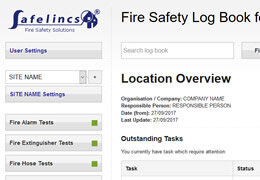-
Contact
Sales & Customer Service
0800 612 6537 support@safelincs.co.uk Live ChatDelivery Enquiries
0800 077 6149 - Resources
Fire & Safety Solutions
CALL OUR TEAM NOW 0800 612 6537
Lines open today 8:30am - 5pm
Free Delivery
on 100s of Products
Secure Payments
with our fast checkout
Live Customer Chat
Available Now
30 Day Accounts
for Public Sector
5 Star Customer Feedback
Help & Advice

A collection of helpful articles and guides designed to help you understand and chose the best products for your requirements.
View Help & AdviceProduct Videos

Videos which are designed to offer introductions, interactive solutions and overviews of our products.
View Product VideosEmergency Lights
Emergency lighting provides immediate secondary lighting when the power supply to the normal lighting fails e.g. due to a fire. The minimum backup duration of emergency lighting as specified by regulations is generally between 1 and 3 hours. For more information on emergency lighting see our emergency lighting guide.
Maintained vs Non-maintained Lighting
Maintained lighting is on at all times and remains on in a power-outage. Non-maintained lighting only comes on when there is a power failure in a building. Non-maintained operation is often favoured, as it is usually cheaper in terms of energy consumption and the life of the components. However, in some premises such as public venues like theatres and cinemas, the luminaires must always be lit (maintained mode) so there is sometimes no choice in the matter. If you are unsure about the requirements for your premises, you should refer to your building’s fire risk assessment.
Emergency Light Regulations and Testing
BS EN 50172 / BS 5266-8 state that an emergency lighting ‘flick test’ should be undertaken every month. A full test should be undertaken annually where all the lights remain on throughout the entire test duration. Responsibility lies with the responsible person to ensure that emergency lighting is working, regularly tested and serviced.
Under the Regulatory Reform (Fire Safety) Order 2005, businesses must install emergency lighting in their premises by law. Responsibility lies with the responsible person to ensure that emergency lighting is working, regularly tested and serviced to illuminate exit pathways so occupants of a building can make their way out quickly and safely.
LED Emergency Lights
LED emergency lights use less electricity and have an improved lifespan of 10 years; they use smaller integrated back-up batteries which saves money on running costs and maintenance. LED emergency lights are also far more energy efficient than standard fluorescent lighting and they contribute significantly to reducing a building’s carbon footprint.



























